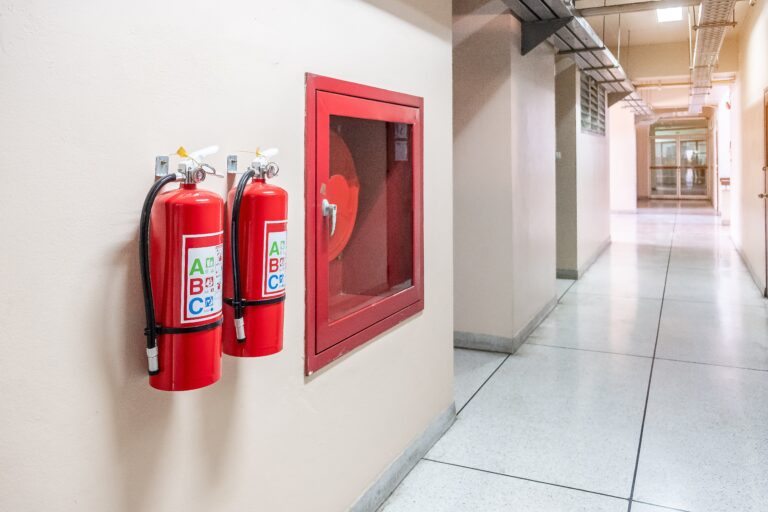
The Fire Triangle: Understanding the Three Components of Fire
Fires are often unpredictable, destructive, and can cause massive loss of life. Understanding how fire works can help us prevent it, predict it, and control it. One of the most
Book your FREE, no-strings-attached Fire Safety Audit to ensure that you’re properly protected from the risk and comply with current fire safety legislation.
Get essential insights and updates
in fire safety – straight to your inbox!

Those of us who are involved in the education of the oncoming generation have a duty of care for the young people involved. They are only young once, and just have one chance. It is our responsibility to ensure that they are safe and protected in the school environment, so that they can fulfil their potential.
We’ve created this guide to share the wealth of knowledge we have in relation to fire safety in the education sector and to make it easy for you to stay fire safe at school.
This guide covers our Top 10 Tips for Fire Safety in Schools to ensure you haven’t missed off any of the really important, but easily overlooked facets of fire safety in the education sector. It provides actionable points and insights to keep you safe and legal at school without eating into your busy schedule.
Regulatory Reform Order (RRO) 2005 states there must be ONE person with overall responsibility for fire safety onsite. This person may delegate roles to other competent persons, but he/she maintains in overall control.
Knowing what has to be checked on a daily, weekly and monthly basis is essential to maintaining all the fire safety equipment in good working order. Email andrew@blazequel. com to request your free fire safety equipment maintenance guides.
Are disabled people going to be in your premises? You must provide a safe means for them to leave if there is a fire. Disabled persons may react differently to a fire evacuation. You may need to create a PEEP (Personal Emergency Evacuation Plan) for them to ensure they are given the required support. Email andrew@dev.blazequel.com to request your free copy of our full PEEP guide and document templates
Time waits for no-one, and neither does fire. In emergencies, instinctive reactions are essential and only come with fire drills and training. Appointed Fire Marshals need to be adequately trained to ensure effective evacuations. By law, anyone with that responsibility (or who may have to use portable fire extinguishers) must receive appropriate training. In an emergency, training saves lives.
Safeguarding strategies are part of everyday school policy – protecting both students and staff. But what happens during the bustle and fluster of a fire evacuation? Have you ensured that your strategy isn’t compromised? Points to consider include:
Every organisation has a responsibility to carry out a Fire Risk Assessment, which forms the basis of all site fire protection measures, and can be requested for scrutiny by the public, insurers, fire officers or a court of law at any time.
Details of all fire risk assessments, service reports, inspection records, recommendations and issues should be recorded in your Fire Log Book. And remember, in the event of an inspection or real fire incident, your insurers, the fire service or a court of law may request to see it as evidence of your procedures, maintenance and training. By law you must provide such reports.
Our EasiComply Fire Log Book has been written to help you stay compliant with all your fire protection responsibilities and record keeping.
Arson is a big problem for schools. In 2001, the cost to the UK of arson attacks at educational establishments was estimated at over £115 million. The best way to prevent arson is proactive housekeeping and student education. This should include a site ‘fire-walk’ on a daily basis to identify and correct potential hazards.
Every day in the UK, 3 schools suffer from Arson attacks. It’s a risk that no public building is immune from, but it can have a potentially devastating impact on your students, staff and facilities.
Proactive housekeeping and being alert to the risks are an essential part of keeping your school safe. Here is some of the most important points to consider, when protecting your school from Arson:
Making sure Fire Alarms function properly is essential. False alarms waste hundreds of pounds in teaching time and fire service time. Even more seriously, they can cause complacency among staff and students – provoking a “crying wolf” attitude. Don’t allow false alarms to become commonplace. Often simple changes such as installing Perspex covers over manual call points can help prevent any malicious or accidental activation. Email andrew@dev.blazequel.com for your free fire alarm system guide.
Risks constantly evolve, so proactive risk assessment approach is essential to keep up with changes to your facility and daily operations. Additionally, fire systems are evolving, with new and better ways to protect you and your facility becoming more cost-effective. For new schools or major refurbishment projects, we support the calls from the London Fire Brigade, the Chief Fire Officers Association (CFOA) and many others to make fire sprinklers mandatory. They save lives and property and are a reliable and cost-effective solution. We also recommend considering automatic fire suppression in high-risk and operations-critical areas. Compact systems are available for retro-fit in kitchens, plant rooms, fume cupboards and server rooms.
The experienced and knowledgeable team at Blazequel are committed to help with your every need. No question too small, no project too big. Let us know and we’ll be more than happy to help!

Fires are often unpredictable, destructive, and can cause massive loss of life. Understanding how fire works can help us prevent it, predict it, and control it. One of the most

Keep your festive season merry and bright with essential Christmas Fire Safety tips from Blazequel. From illuminating your home safely with holiday lights to ensuring your Christmas tree doesn’t become

Staffrooms are a high-risk environment due to the volume of electrical consumers and common office furniture. The following video reconstruction is a forceful reminder of this issue, proving to
Video Smoke Detection is perfect for a fast response to fires in high roofed buildings and harsh operating conditions.
Watch Smokecatcher detect smoke in an MSW storage building. The smoke is coming through from a fire in the adjoining storage area.
Watch Smokecatcher detect a fire in an SRF Storage bunker. Sadly, the alarm wasn’t responded to and the site lost a 4hr window of opportunity between smoke detection and flames appearing.
Video Smoke Detection overcomes the risks of stratification and other challenges for early fire detection in logistics and storage facilities.
Watch Fire Rover detect and suppress a fire in the waste bunker at an EFW facility!
See how the Fire Rover detects and suppresses this fire at a clients tipping hall. Note how the smok is spreading out at low leve, rather than rising. This is called ‘stratification’ and is one of the many reasons why roof-mounted smoke detection systems like beam detectors and HSSD is not suitable for many recycling applications.
Watch the Fire Rover detect and suppress a fire at a battery storage facility. This targeted and intellegent control makes the Fire Rover particularly well suited to high hazard storage applications.
Watch the Fire Rover tackle a battery fire in a tipping hall. Note how the exploding battery cells start three separate fires, which the operator individually suppresses (whilst avoiding the site operators in the vicinity).
Get essential insights and updates in fire safety – straight to your inbox!
